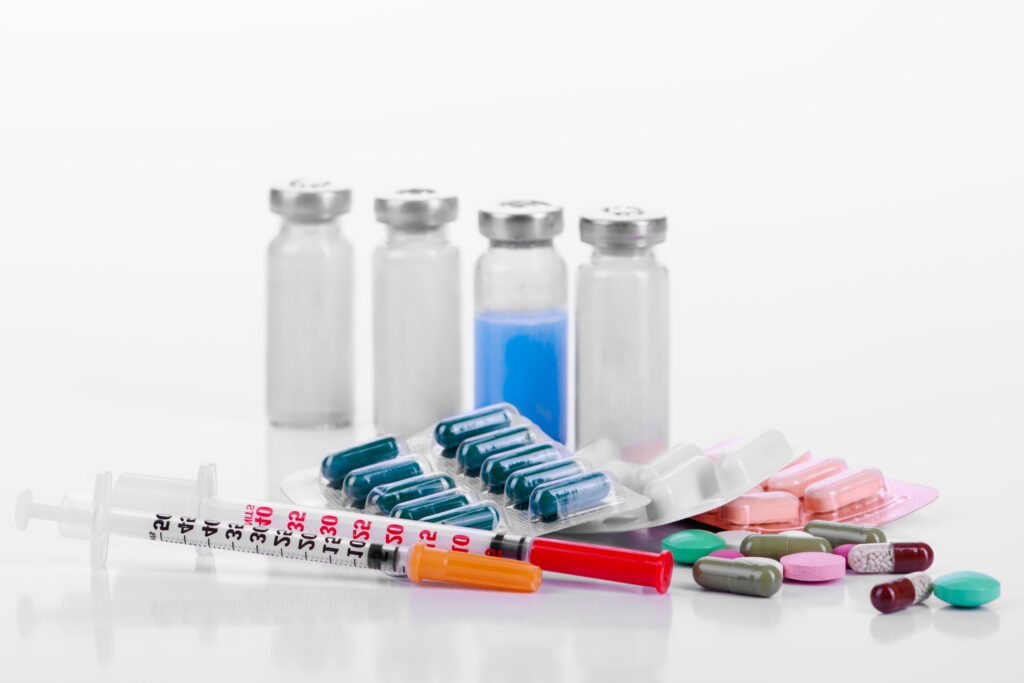Diabetes is one of the most common health conditions in the United States. In fact, 34.2 million Americans (~10%) have diabetes, while 88 million (~27%) have pre-diabetes. The incidence of type 2 diabetes among youth is increasing in many countries, coinciding with increasing prevalence of obesity. While diabetes is commonly associated with obesity, it has two main types: type 1 and type 2. Type 1 diabetes is not caused by obesity but by autoimmune pancreatic beta cell destruction. Because the patient’s body is attacking its own beta cells that make insulin, it does not make much, or any, insulin. Therefore, the most common treatment for type 1 diabetes is insulin. Without insulin, the blood sugar will be very high, which can damage blood vessels. Since they can’t adequately supply blood and oxygen, it can lead to diseases in the vital organs (e.g., eye, kidney, heart). On the other hand, type 2 diabetes is due to a progressive loss of adequate beta cell insulin secretion and insulin resistance. These patients can be treated with non-insulin medications, insulin or both.
One of the main downfalls with diabetes is that patients have to inject themselves with insulin up to four times a day. Insulin injections are not fun for anyone. On top of the physical pain, having to remember the right times to do so is also burdensome, which can significantly affect patients’ quality of life. For as long as insulin has been manufactured, it has only been available as an injectable. It would be pointless to take it as a pill through the mouth because then it will get digested in the stomach instead of reaching the bloodstream where it’s needed. Or will it? Due to the unbelievable advancements over the past 100 years, maybe insulin does not have to be injected up to four times a day anymore. That is why three of the medications in the pipeline stand out. If approved, these medications will significantly improve the quality of life for diabetic patients and provide them with a less painful and more hopeful future.
1.) ORMD-0801 by Oramed (ORMP)
Remember when I said it would be pointless to take insulin by mouth since it won’t reach the bloodstream that way? Well, it turns out that there is a way around that. Due to the special coating of the pill, it can avoid being degraded by the enzymes in the stomach. The phase 2 trials showed very promising results with a significant decrease in A1c levels and fasting sugar levels. A1c is a measurement of how much of the proteins in blood has been coated with sugar over the past three months. Better yet, ORMD-0801’s impact on lowering blood sugar lasted 24 hours, which indicates that this may be dosed just once daily. Because it was also proven to be safe and well-tolerated, it has now progressed to phase 3 trials.
Oramed seeks to develop oral diabetes medications that are currently injectables. If approved, it will be hard to imagine diabetes patients having to inject themselves in a hundred years. It is worth noting that oral insulin is in phase 2 trials to be investigated for use in Non-alcoholic steatohepatitis (NASH), also known as Nonalcoholic fatty liver disease. There is currently no medication used to treat NASH, so this could also be a huge opportunity for profit if it were to get approved, as there are 30 million people with NASH in just the US alone.
As nice as it sounds to replace injectables with oral insulin, there is undeniably a risk that may come with the successful commercialization of it, especially when it comes to its price. Insurance companies may only cover the injectable form of insulin if it is significantly cheaper than the oral version. Or they may only cover the oral version under very special circumstances, such as if a patient has a skin disorder. In addition, because ORMD-0801 is the first of its kind, there is not as much data on safety and efficacy when compared to the over one hundred-year old injectable insulin. Therefore, prescribers may be hesitant to prescribe such a medication. The FDA approval is only the beginning to the commercialization, which is the part that really brings in revenue, so it is definitely an important factor to consider.
Oramed went through quite the roller coaster the past year, from its 52-week low at $4.24 to its 52-week high of $31.54. On January 7, 2022, its price closed out on $12.38. Would this be considered a great opportunity to buy? It may not be the best idea to put all the eggs in one basket, especially if that basket cannot produce any revenue yet as it does not have any approved medications out on the market. However, that basket also has the potential to revolutionize the treatment for one of the most common diseases in the world and a disease that is never going to go away.
2.) Insulin Icodec by Novo Nordisk (NVO)
Due to the possible risk in successful commercialization with ORMD-0801, the pipeline medication that may have a better chance with it is insulin icodec. Patients do not want to inject themselves up to four times a day, but they may not be able to afford the oral version if it gets approved. So there is a great chance that patients and insurance companies will have to compromise by shifting towards insulin icodec, which only has to be injected once a week.
The longest-acting insulin on the market right now is insulin degludec, also known as Tresiba. But even then, it has to be injected every day. Therefore, insulin icodec could serve as a much more convenient alternative. Because there has never been a formulation of insulin that lasts for a whole week in the body, there may be some efficacy and safety concerns. However, when insulin icodec was compared to a once-daily insulin glargine, insulin icodec was shown to be more effective as it helped achieve the blood sugar goal range more without any compromises to safety. The major safety concern with insulin is hypoglycemia, which is when the blood sugar gets too low, and can lead to symptoms such as sweating, shakiness and even passing out. The hypoglycemia risk and the adverse events with insulin icodec and insulin glargine were comparable.
With its stock price nearly doubling within the past year, Novo Nordisk has not yet reached its peak because it continues to find innovative ways to fulfill unmet needs for diabetic patients. Its new obesity medication, Wegovy, has met such a strong market response, that they can’t even make it fast enough. The company is also pursuing new innovations in other disease states, such as hemophilia and growth disorder.
3.) Tirzepatide by Eli Lilly (LLY)
For type 2 diabetes patients, insulin is not the be-all and end-all. In fact, type 2 diabetics only have to take insulin if their A1c is high (over 9%) and if they have symptoms such as frequent urination and weight loss. Therefore, they have a lot of other oral options, such as metformin. But not many drugs work to address type 2 diabetes and obesity at the same time even though 90% of this patient population is either overweight or obese. That is when tirzepatide comes in.
Tirzepatide is a combination of glucose-dependent insulinotropic polypeptide (GIP) and glucagon-like peptide 1 receptor agonist (GLP-1RA). These two hormones increase insulin secretion and inhibit glucagon secretion. This dual action works to lower blood sugar levels. Therefore, tirzepatide is a double threat that reduces A1c levels and leads to weight loss. An A1c level greater than 6.5% is considered to be diabetes. On average, in three clinical trials, tirzepatide reduced A1c levels by 2.5% for those with A1c levels greater than 8% and reduced weight by 13.1%, which was 25 pounds. Tirzepatide’s outcomes are even better than those of its competitors currently on the market, including injectable semaglutide. One of the best things about tirzepatide is that it can be administered once weekly, compared to insulin, which may have to be injected up to 4 times a day, with a minimum of twice a day. If approved, tirzepatide will be the first medication in the GLP-1/GIP combination class. Eli Lilly expects to apply for tirzepatide’s FDA approval sometime in late 2022.
If tirzepatide were to get approved by the FDA, it is a huge win for Eli Lilly and its stock price as it will be the blockbuster medication, not just for type 2 diabetes but also obesity. In 2021, the market value of anti-obesity medications was expected to be $2.4 billion and expected to increase to $5.42 billion in 2025. For type 2 diabetes, the market size value is estimated to grow from $28.5 billion in 2021 to $58.7 billion in 2025. If this medication were to get 15% of the market in 2022 for type 2 diabetes and obesity, that is worth $4.635 billion. Fast forward to 2025, the same 15% would be worth $9.618 billion annually.
Even though there already are many treatment options available for diabetes, there are still unmet needs in this patient population, such as patients having to inject themselves multiple times a day and always having to keep an eye out for their blood sugar levels. Due to its increasing prevalence and the numerous complications that uncontrolled diabetes can lead to, these three pipeline medications are definitely worth keeping an eye out for. Diabetes might not be as “new” as some other diseases, but it is unfortunately just one of those things that is here to stay.






The author failed to mention the mealtime inhaled insulin, Afrezza. Afrezza is the only ultra rapid acting insulin on the market. Afrezza effectively restores the first phase insulin response by matches physiologic insulin. Afrezza is safer than other mealtime insulins, is pain free, poses no risk for the life-threatening iatrogenic medical disease called, insulin-derived amyloidosis like all injectable insulins do (referred to as cutaneous amyloidosis in the injectable insulin labels).
I’m appalled that a pharmacist would neglect the mention of this amazing mealtime insulin. It is perhaps the greatest medical innovation of our lifetime.
I have to agree strongly to the comments regarding Afrezza, a convenient, safe, inhaled human regular insulin, that is as close to the pharmacokinetics of human insulin from the pancreas. Much more physiologic in its action than any subcutaneous insulin, even more effective than short acting insulin mealtime boluses with the newest pumps. I often use it in my type 1 and type 2 diabetics either with a basal insulin like toujeo or tresiba or in my patients on insulin pumps to treat mealtime or for corrections rather than bolusing through the pump, which is no different than taking a pen injection of lispro, aspart, fiasp or Lyumjev, Afrezza is as if your pancreas is working again for mealtime control, but with significantly lower hypoglycemia and weight gain. It is embarrassing to know that the majority of the endocrine community is not even familiar with this product. It has completely changed the quality of my patient’s lives with great convenience, efficacy, and safety.